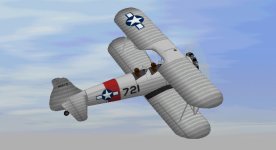Hello Aleatorylamp,
I am glad you found the work on the exposed cylinder radial engine useful.
This critical assembly sequence idea was pretty much what I had been intending all along which is why I was confident it could be done in one or two Components.
I am somewhat surprised though that even with the pushrods, the exposed cylinder radial only costs two Components.
A typical cowled radial in one of my projects normally costs three Components to be bleed free.
I also saw the tail wheel bleed through the aft fuselage but thought it was just another piece of equipment that was supposed to be there.
I haven't followed your recent developments very closely but did you represent the stagger of the pushrods?
It would not be shown in a 2D texture, but pushrods to each cylinder do not enter the crankcase / gear housing in exactly the same alignment because they operate off of different cam drives from the crankshaft.
Incidentally, I just downloaded an overhaul manual for the Continental W-670 a few minutes ago. It probably has more detail than either of us needs for a CFS project.
I found the manual because I was exploring a forum and someone requested technical information on a W-670 removed from a landing craft and that was used for show on a test stand.
The unfortunate thing is that he apparently "Hydraulic-ed" the engine years ago probably from some oil that was pooled in an intake passage. I have not had a chance to go through the manual yet.
Anna Honey is in Switzerland at the moment, so I better go start making dinner. I spoke to her about three hours ago.
- Ivan.
I am glad you found the work on the exposed cylinder radial engine useful.
This critical assembly sequence idea was pretty much what I had been intending all along which is why I was confident it could be done in one or two Components.
I am somewhat surprised though that even with the pushrods, the exposed cylinder radial only costs two Components.
A typical cowled radial in one of my projects normally costs three Components to be bleed free.
I also saw the tail wheel bleed through the aft fuselage but thought it was just another piece of equipment that was supposed to be there.
I haven't followed your recent developments very closely but did you represent the stagger of the pushrods?
It would not be shown in a 2D texture, but pushrods to each cylinder do not enter the crankcase / gear housing in exactly the same alignment because they operate off of different cam drives from the crankshaft.
Incidentally, I just downloaded an overhaul manual for the Continental W-670 a few minutes ago. It probably has more detail than either of us needs for a CFS project.
I found the manual because I was exploring a forum and someone requested technical information on a W-670 removed from a landing craft and that was used for show on a test stand.
The unfortunate thing is that he apparently "Hydraulic-ed" the engine years ago probably from some oil that was pooled in an intake passage. I have not had a chance to go through the manual yet.
Anna Honey is in Switzerland at the moment, so I better go start making dinner. I spoke to her about three hours ago.
- Ivan.

